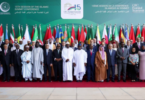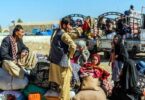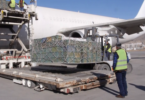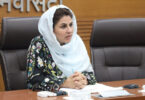KABUL (Agencies): Shafiqa watches closely over her six-month-old niece. Lying on a bundle of fabric, Maryam’s legs jut out, thin and pale. When they arrived at hospital two weeks ago, she could hardly breathe. Her body was swollen with malnutrition, her lips and fingers were blue.
There are 24 children being treated at Mofleh paediatric hospital’s malnutrition ward, on the outskirts of Herat city, western Afghanistan. Mothers and aunts lean next to hospital beds, some rocking tiny babies back and forth. The worst drought in a decade, prolonged conflict and poverty have pushed families across Afghanistan to the brink. About 13.5 million people are severely food insecure – 6 million more than in 2017. This means they are surviving, for the time being, on less than one meal a day.
“That’s the highest number of any country in the world except Yemen,” says Toby Lanzer, the UN’s deputy special representative in Afghanistan. An estimated 3.6 million people are one step from famine. Flash flooding in many areas has compounded the misery families are facing. As US and Afghan Taliban peace talks continue, and the prospect of US troops withdrawing looms, the UN’s appeal to donors – which set a target of $612m (£465m) for this year – is only 11% funded.
Without donor support, Afghanistan would face “a humanitarian tragedy beyond what one could describe”, warns Adele Khodr, Afghanistan’s Unicef representative; the country, she says, could fall apart: “It will become a chaotic situation that can generate insecurity not only for here but maybe elsewhere.” Outside Mofleh hospital, tents stretch into the distance. It’s one of several areas where families who fled the drought have sought shelter. Some sleep in white tents handed out by the UN, others have propped up flimsy pieces of cloth on sticks.
Critics say the response to the drought was slow and failed to support people to stay in their home areas. Alarm bells were first rung by several agencies on the ground, including World Vision, in autumn 2017, but it wasn’t until April 2018 that the government declared a drought. About 260,000 people were forced to leave their homes across northern and western Afghanistan. Advertisement
New arrivals, whose presence in Herat is politically sensitive, are scattered across several sites, making it harder for agencies to provide services. Access to drought-affected areas, where millions more remain, is hampered by insecurity and lack of funding. Rahima Lakzai and her family left their village in the Muqur district of Badghis province four months ago. Almost all their animals had wasted away. There was no money for transport; for eight days, they travelled with two donkeys across the rugged terrain that leads to Herat.
Sitting in a small mobile health clinic, run by World Vision, Lakzai, 22, cradles her youngest daughter. Rakima, 11 months, is wrapped in a red cardigan, a matching scarf tied under her chin. A measurement of her arm circumference – just 11.2cm – indicates she has developed severe acute malnutrition. Rahima is given peanut paste to feed to her daughter, and asked to come back in a week’s time. She says through an interpreter that the family still haven’t been given a proper tent to sleep in and can barely afford food for their two children. Her husband will do any daily labour he can, she says, but there’s little work going.
Torpikae, 35, from Badghis province, lost all 50 of her sheep and three cows in the drought before she fled with her family. “Only a few people remain,” she says. She has received cash handouts, but debt to neighbours means she is not able to keep everything she receives. “Half we give to those [neighbours] we borrowed from,” she says. Like Rahima’s family, Torpikae’s husband goes out to look for work in the city. “Mostly he is jobless,” she says. Herat is one of Afghanistan’s most prosperous and safe cities, but competition for daily labour, which pays up to $5 a day, is tough. Food is abundant in markets, but numerous families – both locals and people who have fled the drought – can’t afford it.
Shafiqa is from Herat province’s Shindand district, an area that has been racked by violence. Maryam’s mother died two days after giving birth, leaving her in Shafiqa’s care. The family has no stable source of income because Shafiqa’s husband is not well enough to work. Before bringing Maryam to hospital, she depended on neighbours for handouts, she says: “I went from house to house to ask for milk.” The effects of malnutrition for children aged two and under are irreversible, says Dr Shakib Popal, of World Vision Afghanistan, which supports the hospital’s malnutrition ward. “The brain of the child will be affected and all the consequences will remain for a lifetime,” he says. Babies often need to stay in the ward for 45 days, adds Popal, but mothers struggle to say away from their families for so long. “I am begging them to discharge me,” says the woman whose baby is next to Shafiqa. Her three-month-old still has swollen legs, but she has eight other children at home.
Families who have been displaced face the greatest barriers to healthcare: on top of discrimination against new arrivals, many are often too preoccupied with finding shelter and food to go for checkups. It was six weeks before Torpikae was given a proper tent. In other areas of Herat, and across eight other provinces including Farah and Kandahar, flash flooding has swept away the shelters used by displaced families. “Some 15,000 families, many of them already affected by the drought, were hit by flash floods, and WFP and partners are responding to cover their immediate food and other needs,” says Zlatan Milisic, country director of the UN World Food Programme in Afghanistan.
Lanzer says that acknowledging and responding to slow onset natural disasters such as droughts typically takes time. Whether or not the response was slow is difficult to judge, and irrelevant, he says. “It’s a bit like counting the number of dead people after an earthquake. It doesn’t matter. We deal with the survivors. “For the past nine months we’ve been doing everything we can with woefully limited resources to do as much as possible,” he says, adding that 5.4 million people were reached with food aid last year. While conditions for displaced families are dire, there are millions more who remain in drought-affected areas.
The effects of the drought are expected to wane. But land degradation – driven by decades of conflict, overuse of natural resources, and climate change – means the full benefits of recent rains aren’t felt. Instead, the risk of flash floods is heightened. “When forests and rangelands are degraded, topsoil erodes. Any loss of plants and the soil they hold in place means that when rains come, the land doesn’t benefit as much as it should,” says Rajendra Aryal, the UN Food and Agriculture Organization’s representative in Afghanistan, which is working with the ministry of agriculture, irrigation and livestock to restore forests and rangelands.
Over the past decade and a half, droughts have become more frequent and more serious. It’s likely this trend will continue, creating food crises, prompting large numbers of people to flee their homes, and increasing the risk that water conflict will exacerbate existing ethnic tensions. Many of those who have fled to Herat do not want to return home. “Even if this year is a good year [for rains] we do not have resources there,” says Rahima.
Shafiqa will stay in the hospital for another two weeks, before she goes back to her children in Shindand. “I have heard from others that the government is going to make peace with the Taliban,” she says. “I hope peace comes to my district.” Shafiqa says her children are used to the fighting. “We have a shelter underground we go to … once, we were in it for a whole night. When they hear the firing sound, they just come and stick to me.”






